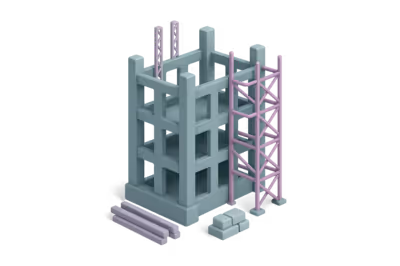Fundamentals of Structures
Types of Structures
Isostatic Structures
Structures that can be analyzed using only the equations of equilibrium, without considering the deformability of materials.
Hypostatic Structures
Structures that have fewer equations of equilibrium than unknowns (substatic).
Hyperstatic Structures
Structures that have more unknowns than equations of equilibrium. Deformations must be considered to solve them.
Equilibrium of Forces
For a body to be in equilibrium, the following equations must be satisfied:
Sum of Forces in X
Sum of Forces in Y
Sum of Moments
Types of Loads
Concentrated Load (P)
Force applied at a specific point of the structure.
Uniformly Distributed Load (w)
Where:
is the total force, is the length of the distributed load.
Triangular or Trapezoidal Load
For variable distributed loads, load functions can be used:
Where
is a constant defines the variation of the load
Variable Loads
For variable loads, load functions are used:
where
Beam Analysis
Internal Stresses in Beams
Shear Force (V) and Bending Moment (M)
- Shear is the derivative of the moment with respect to the length of the beam.
Simply Supported Beam with Point Load at Center
Reactions
Moment at Center
Maximum Deflection (at center)
Beam Fixed at One End and Free at the Other (Cantilever)
Maximum Moment
Maximum Deflection (at free end)
Simply Supported Beam with Uniformly Distributed Load
Maximum Moment (at center)
Maximum Deflection
Beam Fixed at Both Ends (Fixed or Continuous Beam)
Maximum Moment
Maximum Deflection
Truss Analysis
Method of Joints
The joint analysis implies that the forces at each joint must be in equilibrium:
Method of Sections
Cutting the truss and applying the equations of equilibrium on the obtained section:
Material Deformation
Hooke’s Law
The relationship between stress (
Where
Axial Deformation in a Bar
For a bar subjected to an axial force
Where:
is the cross-sectional area, is the length of the bar, is the modulus of elasticity.
Structural Stability
Euler’s Criterion for Columns
The critical buckling load for a column is:
Where:
is the effective length factor that depends on the support conditions.
Factor of Safety
The factor of safety (FS) is defined as:
Moment and Shear Analysis
Free Body Diagram
The first step in structural analysis is to create a free body diagram, to identify the applied forces and moments.
Equations of Equilibrium
For each section of the structure:
Shear and Bending Moment Diagrams
Shear (V)
Represents the transverse force at a section of the beam.
Bending Moment (M)
Represents the moment at a section.
Numerical Methods in Structures
Finite Element Method (FEM)
Divide the structure into finite elements and apply the equilibrium formulation:
Where:
is the stiffness matrix, is the displacement vector, is the force vector.
Stiffness Method
This is a method that calculates displacements and internal forces in complex hyperstatic structures.
Dynamic Analysis
Equations of Motion
For a dynamic system, the equations of motion are expressed as:
Where:
is the mass matrix, is the damping matrix, is the stiffness matrix, are the acceleration, velocity, and displacement vectors, respectively.
Natural Frequency of Vibration
The natural frequency of vibration of a structure is:

